Are you interested in bee farming?
Or, maybe you’re a bee nerd like me, simply hoping to find some useful information.
Either way, let’s dive right into the topic.
Here’s a list of some of the most essential bee farming equipment you’ll need. Know all about beginning beekeeping supplies.
1. Hives
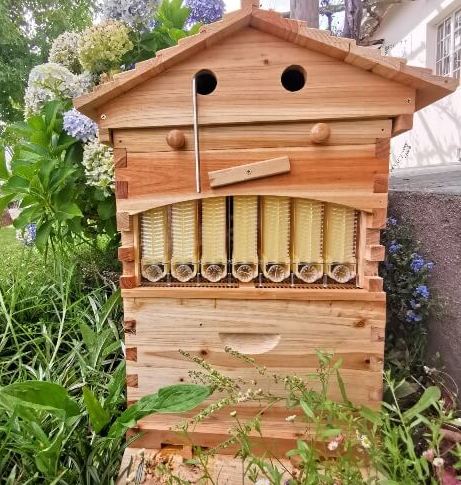
What kind of bee hive do you fneed to start beekeeping?
The most common style is the Langstroth hive. This type is characterized by boxes that stack right on top of each other. It also features removable frames.
These are the components of this hive:
- Telescoping/outer cover: This looks like the roof of a house. It keeps the hive dry, protecting it from the rain.
- Inner cover: Commonly used with a bee escape while harvesting honey, this inner cover ensures that frames don’t stick to the outer cover. Additionally, it also helps provide insulation.
- Shallow/honey super: This is the part used to collect honey.
- Queen excluder: This isn’t very commonly used equipment. It is used to keep the queen bee away from the honey and prevent them from laying eggs in the honey super.
- Frames: Bees build honeycomb inside these. They are made to fit inside the hive boxes.
- Foundation: Sheets of beeswax are usually used to serve as a foundation to guide bees to build a straight honeycomb inside the frames.
- Brood chamber: This is like a maternity ward. It’s where the queen lays eggs.
- Bottom board: This is, quite simply put, the base of the hive.
In addition to this particular hive, there are other hives such as the Warré Hive and the Top Bar Hive.
If you want to learn more about choosing the right hive (and much more!), here’s an interesting book on Beekeeping For Beginners.
2. Frames
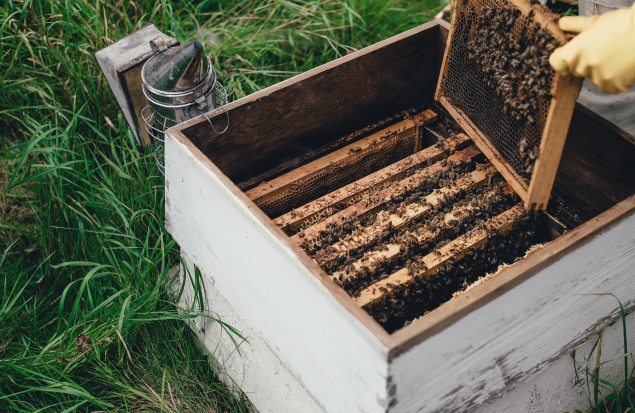
One of the most essential apiculture tools and agriculture apiculture needed for beginner beekeeping is the frame.
As mentioned above, the frame of a hive is where the bees build their comb. Inside these frames, the bees prepare for winter, make honey, and lay brood.
3. Smoker
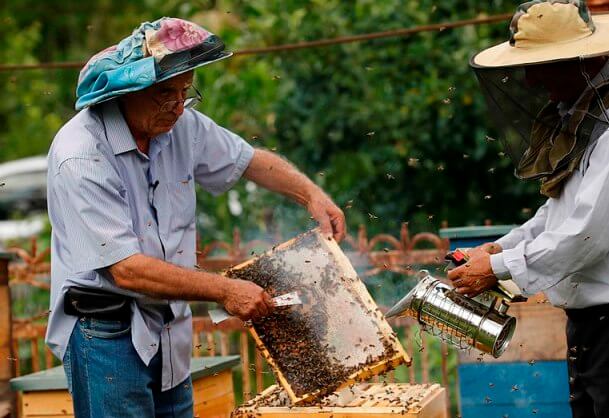
If you’re wondering “what equipment do I need to start beekeeping?”, the smoker is one of them.
If you want to avoid being stung, please get a smoker! When you squirt smoke inside the hive, the bees stay away from you and hence don’t sting you.
Don’t want to shop for one? You could make one on your own with the help of this book on How to Construct A Smoker for Beekeeping.
4. Hive Tool
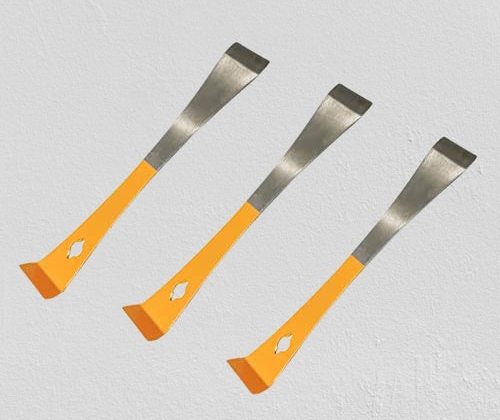
You definitely need a hive tool. This is because bees line their hives with a gooey bee byproduct called propolis. This material is sturdy and so it gets difficult to pull the frames & hive bodies apart. This is why you need a hive tool.
To learn more about the characteristics of propolis, check out this article on Propolis: A Wonder Bees Product and Its Pharmacological Potentials.
5. Queen Catcher
You don’t want the queen to lay eggs in the honey super, which will make the harvesting difficult. So, you’ll need a queen catcher. This device allows you to keep the queen out of the supers.
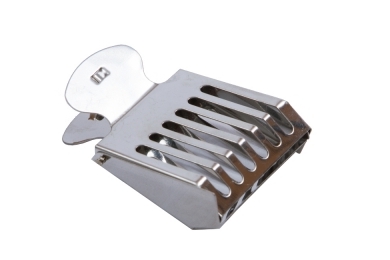
6. Comb Foundation Sheet
As mentioned before, one of the components of The Langstroth hive is a foundation sheet; it is used in frame hive keeping to:
- Guide bees to make straight combs inside the frames.
- Save bee’s labor and resources in comb constructions, thereby allowing them to produce more honey
- Help with honey extraction
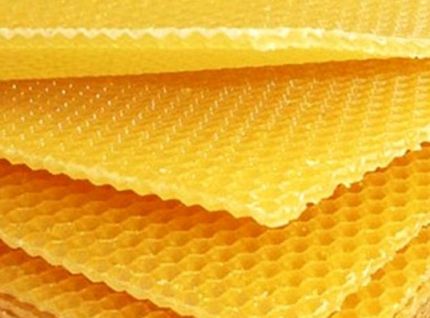
7. Electric Wire Embedder
This is a tool that is used to fix the foundation sheet on the frame’s wires. It’s a small tool with a round wheel on top.
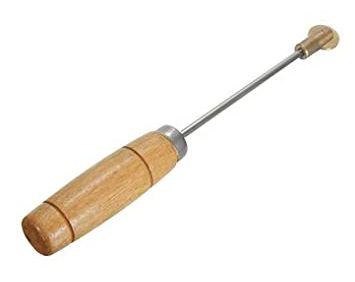
8. Pollen Trap
Pollen traps help scrape the pollen pellets collected on the legs of foragers. How? This device forces bees to crawl through tiny openings. The openings are so tiny that the pollen traps strip the bees off the pollen. The collected pollen serves as protein that can be used for queen rearing or brood rearing.
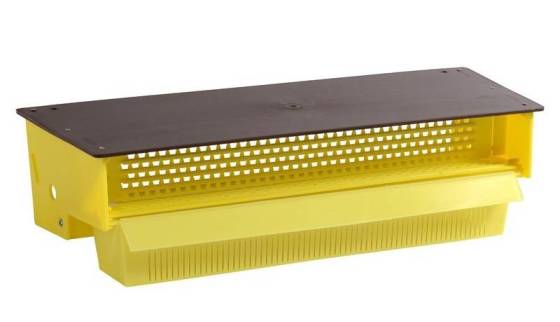
9. Drone Trap
The Drone Trap is a tool that is used to reduce the drone population within the hive. It’s a box with one side fitted with a queen excluder sheet and the other side left open. It’s a great way to trap drones.
10. Queen Cell Protector
As the name suggests, this tool fits around a queen cell and aims to protect her.
This is because sometimes other bees destroy queen cells without realizing it.
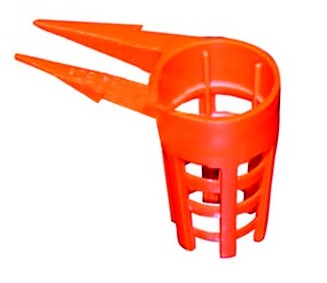
11. Bee Suit
Among the wide range of honeybee equipment, you’ll need a bee suit. It’s essential you purchase a bee suit in order to keep yourself protected from bee stings!
What kind of bee suits are available? You have separate & all-in-one bee suits.
With separate suits, you can wear your trousers with separate smocks or beekeeping jackets, paired with a veiled hat or a hood. One perk of this kind of suit is that if one part of your outfit is damaged, you can still replace that particular part.
All-in-one suits on the other hand are suits that provide full coverage. A great advantage to this kind of suit is that it has fewer gaps, preventing bees from entering the suit and stinging you.
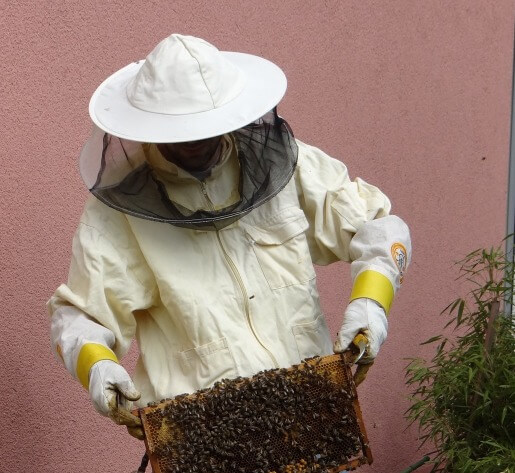
12. Gloves
Digging through a beehive isn’t easy. Especially if you don’t have gloves! Remember to buy gloves of sturdy material so that you don’t expose your skin.
Exactly what kind of beekeeping gloves should you buy?
Leather gloves: You could go for cow or goat leather. Cow leather is thicker and gives more protection from stings. However, it also makes the skin less sensitive so you might not even realize when you’re placing a finger on a bee. For this reason, goat leather could be better.
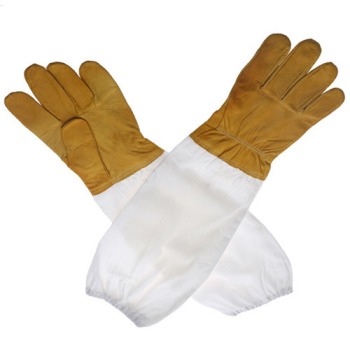
Nitrile gloves: Nitrile gloves are disposable but easier to clean. Although they’re thinner than leather gloves, bees don’t seem to realize they can actually sting you through them. These gloves also provide increased sensitivity which means you can even feel the heat from the hives! One major con of nitrile gloves is that they don’t allow the skin to breathe. This causes your hands to sweat.
It’s advised to first start off with leather gloves, then slowly move to nitrile once you’ve got a sense of how to keep the bees calm, and then eventually transition to gloveless when you’re more confident.
13. Shoes
Don’t think about beekeeping if you don’t have shoes that completely cover your feet! Because you’re going to be stung.
You’ll find that bees go right to the ankles. So, it’s recommended that you shop for boots. Preferably short muck boots that are about mid-calf. This way, they’re easy to take off and don’t interfere with your bee suit either.
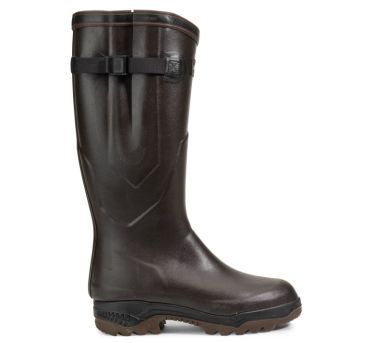
14. Essential Oils
Essential oils can really do wonders when you want to get rid of hive beetles, simply want to repel bees during bee inspections, or attract new bees to hives.
It also helps in calming bees after a colony has gone through some structural changes.
Anxious about hive beetles? We’ve found an article on Small Hive Beetles you might find useful.
15. Feeders
At some point, you will need a feeder for your hive. Simply mix sugar and water and place it inside your feeder. If you’re worried about other bees robbing this mixture, purchase feeders that you can place inside your hive.
16. Sugar
You will face a situation where your bees rely on you for food supply. That’s when you must make the syrup of sugar and water.
17. Queen Excluder
In order to prevent your queen bees from laying eggs in the honey super (same reason you should buy a Queen Catcher!), you can purchase a queen excluder. Like the name suggests, this tool will exclude the queen.
18. Queen Marker
When you just start beekeeping, you might find it hard to identify the queen bee. For that reason, it’s best if you mark her with a bright marker.
19. Bees
An alternative to catching your own swarm is to purchase bees on your own.
You can choose to purchase package bees or a nucleus hive.
If you want to order a package of bees, you must first contact a bee supplier. Usually, packages will consist of a queen bee, many worker bees, and a feeder that has sugar syrup. Ensure you get the information you need from your bee supplier, such as how to install the package, and how to introduce the queen bees to the worker bees. Commonly, the queen is introduced to the workers when the workers make their way to the food plug in her cage.
Alternatively, you could also order a nucleus, which is half of a bee colony. The most common nucleus size is a 5 frame nuc. Although this will give you a jumpstart in colony growth, it’s still risky. This is because there’s an increased risk of pests and diseases spread by honeycombs.
20. The Queen
There may come a time where you don’t have much success with your beehive. In times like these, you could consider purchasing your own queen bee.
Learn more about why queens should be replaced and how to choose replacement queens in this article on Buying Queen Bees.
What about used beekeeping equipment?
Beekeeping supplies could be expensive. So, shopping for commercial beekeeping equipment could seem unnecessary.
That’s when shopping for used beekeeping equipment could be a good idea. So, after you wonder, “where can I find used beekeeping equipment near me?”, ensure you keep a few things in mind:
- Don’t purchase second hand equipment that’s hard to clean. If it’s hard to clean, you’ll find it hard to contain the spread of diseases. The same goes for purchasing secondhand brushes!
- Although you may find bee equipment for sale, the comb from used beehives is not safe. Beeswax can contain several pathogens. Do try to avoid using old honeycombs because there is no safe way to sanitize and clean honeycombs.
- Make sure to properly launder second hand bee suits/clothing or even recycle them.
- There are several used beehives for sale. After you buy one, make sure to use a blow torch for your second hand beehives to completely eliminate the possibility of diseases. AFB (American Foul Brood) is a common bacterial disease) could kill young bees!
- When it comes to used beekeeping tools (such as bee smokers), you should ensure they’re free from residual honey, pollen, propolis, and comb. Do not purchase out-of-date, very old tools for your hive! However, using old tools is still okay, provided you clean them properly.
- Please don’t purchase used frames! They are too dangerous and are difficult to clean.
- All in all, sterilize your used commercial beekeeping equipment properly before use.
Related Articles:-